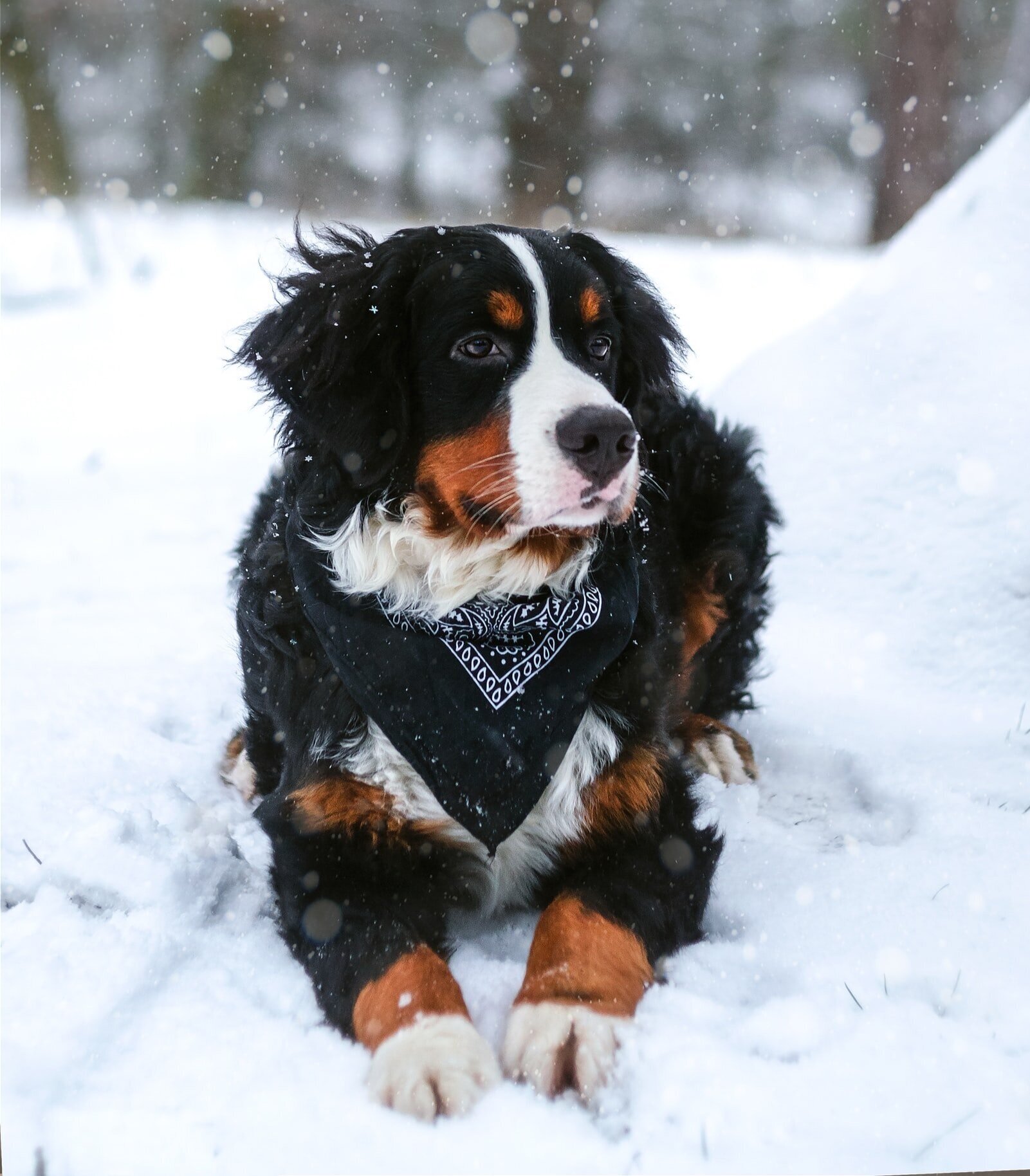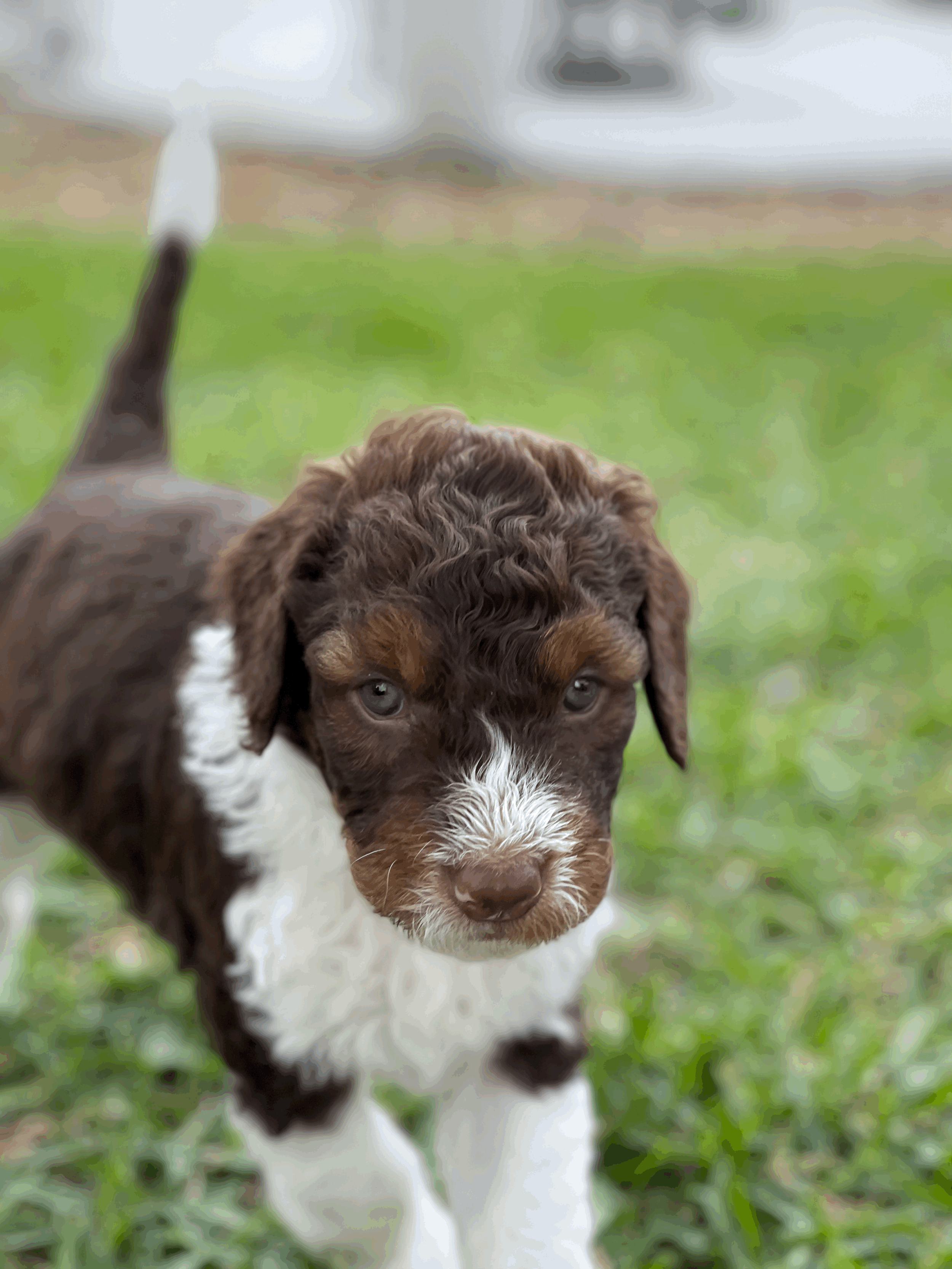ABOUT BERNEDOODLES
I first heard of a Bernedoodle while searching for a Labradoodle. I had Labs for many years, and truly love the breed. I did (and still do!), however, have my hands full with homeschooling 3 very active children and had decided to look for a poodle mix because constant sweeping of dog hair was one thing I wished to take off my to do list. I had never met a Bernese Mountain Dog but learned that they were also being bred to poodles in order to produce a large, somewhat lower energy hybrid breed that was just as family-friendly, beautiful and hypoallergenic as their retriever doodle cousins. I have a LOT of energy already in my home, and this idea appealed to me immediately! I started looking into Bernedoodles and knew that this was what I wanted for my family. I have been beyond pleased with our Bernedoodle, and know they can be a wonderful addition to your family too!
What is a Bernedoodle?
So just what is a Bernedoodle anyway? Well, simply, it is a combination of a Bernese Mountain Dog and a Poodle! Sometimes you will see letters behind the name of the doodle, such as F1, F1b, F2, multigen, etc and I’ll talk a little about that below, but first let’s take a quick look at the 2 breeds involved in creating this wonderful hybrid.
The Bernese Moutain Dog
The Bernese Mountain Dog - or Berner - as they are often called, hails from the Swiss Alps. Able to pull up to 10 times their body weight, these large dogs were originally bred as a hardworking dog for the family farm. The easygoing nature, intelligence and loyalty that endeared them to the Swiss, has also caused them to be a desirable family dog for the modern family. A common mannerism of the Berner is the “Berner Bump” which is a tendency to lean into your body or repeatedly lift your hand with their head in an effort to maximize the attention of and interaction with their people. They do, however, have very thick, luxurious coats and tend to shed copiously as well as tending to be shorter lived, as their relatively small gene pool unfortunately makes them prone to several health problems. They can also occasionally be stubborn and have a shy or sensitive nature. Overall though, their calm and extremely loyal natures tend to make these “gentle giants” very popular in the dog world.
The Poodle
If your only idea of a poodle is one in continental cut (think poodle emoji), you probably seriously underestimate this magnificent breed. They are known to be one of the most intelligent dog breeds (second only to the Border Collie) in terms of how quickly they learn new commands and their willingness to obey known commands. They also greatly enjoy interacting with their owners and partaking in exercise. This makes them excellent working dogs to serve as guides and therapy dogs as well as bird dogs who excel in sporting capacities. It also contributes to the marked curiosity and playfulness that exemplifies this breed, often thought of as “class clowns.” Their unique, low- to non-shedding coat is also desirable to people who have allergies to dog dander, but sadly, they can be prone to health problems.
Photo by Kurt Pas/iStock / Getty Images
The Bernedoodle
Overall, the reason to breed any dog is to propagate elements of the parents that are a credit to their breeds or species. Specifically, I feel that Bernedoodles as a hybrid breed accomplish this in several ways. First and foremost is something called Hybrid Vigor. In biology it is known that crossing of two diverse individuals results in offspring that are superior to the parents in many characteristics, presumably due to the enlargement of the gene pool. In the case of the Bernedoodle, this means that many of the health concerns that affect purebred members of both parent breeds are not frequently seen in the hybrid. They are generally healthier and stronger! Secondly, we have the opportunity to combine personality characteristics common to both breeds that results in a uniquely desirable dog. A dog with the intelligence and playfulness of a poodle combined with the loyalty and gentleness of a Berner is special dog indeed. Lastly, is the appearance and hypoallergenicity of the hybrid. Bernedoodles can have a variety of coats, but in general most have wavy or curly coats due to the poodle cross. The curlier the coat the less it sheds and the lower the allergenicity. (Note: this only applies to allergies to dog dander. If your allergy is to dog saliva, you will most likely be allergic to all dogs regardless of coat.) The curly coat also requires more maintenance: regular brushing and routine grooming are required. Additionally, many people greatly admire the “teddy bear” appearance of their coats.
Ultimately, it is my desire to breed Bernedoodles who are exceptional companion dogs. Some may be more energetic and water-loving like their poodle parent and some may be more stubborn and sensitive like their Berner parent, but I strive to produce handsome, low allergy dogs with bomb-proof temperaments who want nothing more than to be with their humans in work, play, and rest.
Breed Mismatch
What a dream dog, right?!?! Well, even Bernedoodles produced by extremely conscientious breeding may not be a good fit in a few situations.
They are extremely social dogs. They crave attention from their owners and would love nothing more than if they could fit into your pocket and be with you constantly. If your lifestyle does not afford you much time to spend with your dog, a more independent breed may be better for you.
Some individual Bernedoodles may be higher energy (Poodle) or more shy/sensitive (Berner). Both of these traits may require some special attention, such as increased opportunity to exercise vigorously or intentional attention paid to socialization, especially at a young age. If the possibility of working with a dog in such a way to bring out the best in it does not interest you, another breed might be a better choice.
They will have gorgeous, fluffy coats. Those coats will require effort to maintain: brushing and grooming. If you are not interested or able to do so, I would reconsider adopting a Bernedoodle.
Generations
Generations refers to the parentage of individual dogs, as described below.
F1- A cross between a Bernese Mountain Dog (50%) and a Poodle (50%). All coat types are possible, but in general they usually have fluffy, wavy coats and are low shedding. Some F1 dogs have curlier coats and are thus even lower shedding, and some can have flat coats and typical shedding. They can be a good choice for a family with mild allergies.
F1B- A cross between an F1 Bernedoodle and a Poodle (25% BMD and 75% Poodle). This generation has wavy to curly coats and tends to be the lowest in terms of allergenicity and shedding. An F1B Bernedoodle is a smart, affectionate, agile family dog with a minimally shedding that coat will serve most families.
Reverse F1BB - Starting in 2023 we will also have some litters of this generation. They will be a cross between a carefully chosen F1B Bernedoodle and an AKC Bernese Mountain Dog. This results in a dog that is genetically approximately 62.5% BMD and 32.5% Poodle, however, the F1B Bernedoodle parent has been specifically selected for breeding in this manner because of both her temperament and her outstanding coat quality. This cross will produce all furnished puppies with wavy coats and low shedding.
F2- A cross between 2 F1 Bernedoodles. These dogs will be 50% BMD and 50% Poodle, but because of the nature of the cross, the individual puppies can vary widely and unpredictably with certain puppies having flat, shedding coats and strongly resembling a Berner to having an extremely curly coat and resembling a Poodle.
F2B and Multigen - Any crosses not specifically stated above. There can be a lot of variety in these generations depending on the individual parents.




